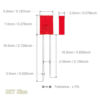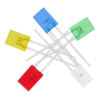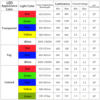Emitting Color: White/Red/Green/Blue/Yellow
Light Emitting Angle: 160 Degree
Forward Voltage :2.0-2.2V (Red / Yellow) | 3V-3.2V (White /Green / Blue )
Current: 20mA
Polarity: Anode (Longer Part) | Cathode (Shorter Part)
1. Ultra thick LED pins, not easy to break, longer service life.
2. Imported chips, overseas vertical chip packaging technology, high light efficiency, built-in ESD, stable luminescence, pure light, and reliable quality.
3.Transparent colloidal lamp made of quality resin adhesive, and the colloidal lamp is clear, free of impurities and bubbles, strong refraction, and high brightness.
4.Silver plated bracket, using a thick silver plated bracket, easy to tin, strong heat dissipation, non oxidizing, good thermal conductivity, and easy to store.
Positive and Negative Electrode:
(1)Positive and negative pins: the long pin is positive, the short pin is negative.
Pin Forming Method:
(1) It is necessary to be 2mm away from the colloid to bend the bracket.
(2) The forming of the bracket must be completed using clamp or by professional.
(3) The forming of the bracket must be completed before welding.
(4) The formation of the bracket needs to ensure that the pins and spacing are consistent with those on the circuit board.
LED Installation Method:
(1) Pay attention to the arrangement of external wires of various devices to prevent incorrect polarity installation. The device should not be too close to the heating element, and the working conditions should not exceed its specified limits.
(2) Be sure not to install LEDs with deformed pins.
(3) When deciding to install in the hole, calculate the size and tolerance of the hole spacing on the surface and circuit board to avoid excessive pressure on the bracket.
(4) When installing LEDs, it is recommended to use guide sleeves for positioning.
(5) Before the welding temperature returns to normal, must to avoid any vibration or external force on the LED.
Cleaning:
(1)Special care must be taken when cleaning colloids with chemicals, as some chemicals can damage the surface of the colloids and cause discoloration, such as trichloroethylene, acetone, etc. Ethanol can be used to wipe and soak, and the time should not exceed 1 minute at room temperature.






























